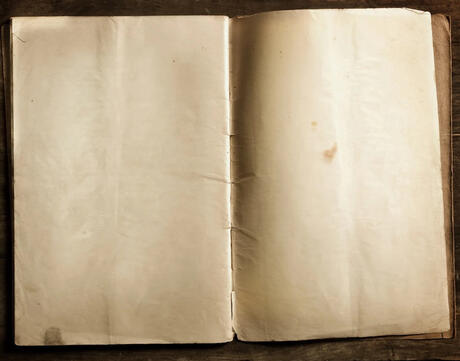
The Problem of Archival Silences
Have you ever wondered how history itself is made? Though we often talk about individuals and groups “making history” by making certain types of contributions to society, less frequently do we talk about the complex process through which historians construct their accounts of the past. During American Archives Month this October, we have a chance to explore the central role of archives in shaping our perceptions of the past, the various forces that determine the materials and voices included in a given archive, and how this insight can enrich the way we think about historical materials and even produce our own.
The word “archive” has at least three distinct meanings. First, it refers to records—such as letters, reports, accounts, minute books, manuscripts, and photographs—produced by people, businesses, and governments that have been kept because they are thought to offer future reference value. Second and third, it refers to organizations dedicated to this work of record preservation and even the physical spaces in which records are held. Institutions that have historically been repositories of archival material include libraries, universities, places of worship, hospitals, prisons, and governments—each with their own distinct reasons for and approaches to collecting data. Historians regularly turn to the archives of these types of institutions and others in an effort to deepen, complicate, or challenge existing understandings of the past. As much as there is to learn from these existing materials, it is also vital that we ask a number of critical questions about what a given archive may leave out, for what purposes it was assembled in the first place, and what this means about the stories it enables historians to tell.
A prominent example of these tensions surfaces in the work of historians of antebellum slavery in the United States. Archival documents like bills of sale, auction notices, and manumission papers for slaves are among the primary source materials out of which this group of historians has gained insight into the past. But these are documents that were initially generated and kept as part of a system that existed to uphold the system of slavery, not to provide a rich accounting of the voices and lives of the people who were being bought, sold, auctioned, and freed. The absence of these voices and insights is what is described as an “archival silence”—defined as “the unintentional or purposeful absence or distortion of documentation of enduring value, resulting in gaps and inabilities to represent the past accurately.”
If one attempted to tell the story of antebellum slavery using only the conceptual resources contained in those types of primary sources, the resulting history would ultimately tell us very little about what was actually going on in that time in the lives of the enslaved and in other domains. The emergence of the Slave Narrative Collection—an archive that contains interviews conducted with over 2,000 formerly enslaved people in the 1930s—played an important role in revitalizing scholarship on the history of slavery for this reason, and is among the sources that historians now turn to when trying to construct more complete narratives about the past. In addition, Black scholars attuned to the problem of archival silences are increasingly employing innovative research strategies that lead them beyond traditional archives.
Irrespective of the historical period or phenomenon a historian wants to study, the crucial point here is that archival collections are not neutral; they come into existence for particular purposes within specific institutional contexts, and strategically include and exclude material according to those purposes. The politics of the archive is one of many factors that drives the writing of “histories from above” rather than “histories from below” or “people’s history”—a mode of historical scholarship in which the scholar deliberately places the experiences and insights of non-elite actors at the center of investigation.
A particularly poignant attempt to forge a “history from below” in real time is found in the riveting story of the Oyneg Shabes—a clandestine archival organization that formed in the Warsaw Ghetto to narrate the unfolding events from a Jewish perspective, as well as capture the richness of Jewish cultural life and agency that persisted in the face of the Nazi German occupation. The organization was started by Jewish historian Emanuel Ringelblum who observed the Nazis documenting Jewish life in the Ghetto as part of a coordinated effort to dehumanize them and advance antisemitic notions of Jewish inferiority.
As a historian, Ringelblum understood the problem of archival silences—that, in this case, the interests of the Nazis documenting these events would likely drive the historical narratives subsequently produced in the absence of countervailing evidence. With the help of his team of collaborators, Ringelblum resolved to assemble the raw materials out of which a counterhistory could later be forged. Together, the Oyneg Shabes gathered what in the archival lexicon is known as “ephemera”—essays, diaries, drawings, posters, paintings, poetry, underground newspapers, and more—from everyday people living in the Ghetto before burying the collection in the ground for safe keeping. Though most of the members of the Oyneg Shabes did not survive the Holocaust, much of the archive was later unearthed and enabled the production of new historical knowledge about the time period from a Jewish perspective. Among those texts is historian Samuel D. Kassow’s book Who Will Write Our History?: Emanuel Ringelblum, the Warsaw Ghetto, and the Oyneg Shabes Archive.
The problem of archival silences reveals that there are important questions for teachers and students to ask of the primary and secondary sources they explore in the classroom, and that the answers to those questions may be just as, if not more, illuminating than the contents of the sources themselves. Questions like where did this source come from; why was it kept and by whom; and whose voices are we not hearing are among the vital questions that we can consider as we examine primary sources and secondary accounts.

Help Your Students Connect Identity and History
For ideas surrounding how to engage students in telling their stories and sharing them with their communities, we encourage educators to check out the curriculum outline for our unit Identity and Community. This outline captures an 18-week curriculum that culminates in a chance for students to develop and share their own short stories about who they are and what they believe.
The problem of archival silences can also be an invitation to construct one’s own archive in the present. By seizing opportunities to express ourselves in the here and now, we can not only contribute to collective life but also to the pools of data that may be used to narrate the history of this time in the future. As scholars increasingly turn to the internet as a repository of historical knowledge, the opportunity for an everyday person to “write” oneself into the historical record is perhaps more available now than ever before. Whether through podcasting, writing, YouTubing, or other mediums, young people have an unprecedented opportunity to help make history as future people will know it simply by making their insights and experiences legible using these tools.

